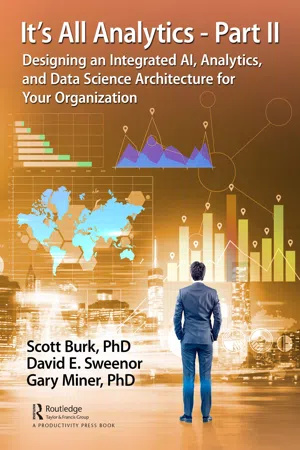
It's All Analytics - Part II
Designing an Integrated AI, Analytics, and Data Science Architecture for Your Organization
Scott Burk, David Sweenor, Gary Miner
- 240 Seiten
- English
- ePUB (handyfreundlich)
- Über iOS und Android verfügbar
It's All Analytics - Part II
Designing an Integrated AI, Analytics, and Data Science Architecture for Your Organization
Scott Burk, David Sweenor, Gary Miner
Über dieses Buch
Up to 70% and even more of corporate Analytics Efforts fail!!! Even after these corporations have made very large investments, in time, talent, and money, in developing what they thought were good data and analytics programs. Why? Because the executives and decision makers and the entire analytics team have not considered the most important aspect of making these analytics efforts successful. In this Book II of "It's All Analytics!" series, we describe two primary things: 1) What this "most important aspect" consists of, and 2) How to get this "most important aspect" at the center of the analytics effort and thus make your analytics program successful.
This Book II in the series is divided into three main parts:
Part I, Organizational Design for Success, discusses ……. The need for a complete company / organizational Alignment of the entire company and its analytics team for making its analytics successful. This means attention to the culture – the company culture culture!!! To be successful, the CEO's and Decision Makers of a company / organization must be fully cognizant of the cultural focus on 'establishing a center of excellence in analytics'. Simply, "culture – company culture" is the most important aspect of a successful analytics program. The focus must be on innovation, as this is needed by the analytics team to develop successful algorithms that will lead to greater company efficiency and increased profits.
Part II, Data Design for Success, discusses ….. Data is the cornerstone of success with analytics. You can have the best analytics algorithms and models available, but if you do not have good data, efforts will at best be mediocre if not a complete failure. This Part II also goes further into data with descriptions of things like Volatile Data Memory Storage and Non-Volatile Data Memory Storage, in addition to things like data structures and data formats, plus considering things like Cluster Computing, Data Swamps, Muddy Data, Data Marts, Enterprise Data Warehouse, Data Reservoirs, and Analytic Sandboxes, and additionally Data Virtualization, Curated Data, Purchased Data, Nascent & Future Data, Supplemental Data, Meaningful Data, GIS (Geographic Information Systems) & Geo Analytics Data, Graph Databases, and Time Series Databases. Part II also considers Data Governance including Data Integrity, Data Security, Data Consistency, Data Confidence, Data Leakage, Data Distribution, and Data Literacy.
Part III, Analytics Technology Design for Success, discusses …. Analytics Maturity and aspects of this maturity, like Exploratory Data Analysis, Data Preparation, Feature Engineering, Building Models, Model Evaluation, Model Selection, and Model Deployment. Part III also goes into the nuts and bolts of modern predictive analytics, discussing such terms as AI = Artificial Intelligence, Machine Learning, Deep Learning, and the more traditional aspects of analytics that feed into modern analytics like Statistics, Forecasting, Optimization, and Simulation. Part III also goes into how to Communicate and Act upon Analytics, which includes building a successful Analytics Culture within your company / organization.
All-in-all, if your company or organization needs to be successful using analytics, this book will give you the basics of what you need to know to make it happen.
Häufig gestellte Fragen
Information
II DESIGNING FOR DATA SUCCESS
Chapter 4 Data Design for Success
The world is one big data problem.Andrew McAfee, principal research scientist, MIT
Currently, seven out of the ten highest valued global brands are data companies. Data as the new oil? Clearly. When you invest in data, its storage, its management and its analysis, you’re investing in innovation.Thomas Harrer, CTO, IBM Systems
Introduction
It’s about the data…. Exactly! The world isn’t run by weapons anymore, or energy, or money, it’s run by little ones and zeroes, little bits of data. It’s all just electrons.Sneakers
You can only offset the costs of all that data if you use it to the benefit of your organization.
We were crippled for lack of data, nothing else.
Why Is Data So Important?
So I started watching that (pointing to the leader/information board) instead of watching that (pointing to the track).The numbers told the story, they always do.
Data Is the Cornerstone of Improvement
- Maintaining status quo
- Improving on the status quo
- Determining how I am doing
Processes Are Everywhere
The Problem – Issues with Data Continue to Persist
Inhaltsverzeichnis
- Cover
- Title Page
- Copyright Page
- Dedication Page
- Table of Contents
- Foreword and Tribute to the Authors
- Preface
- Authors
- SECTION I Designing for Organizational Success
- SECTION II Designing for Data Success
- SECTION III Designing for Analytics Success
- Index